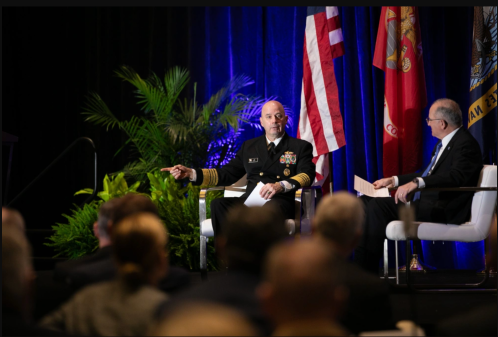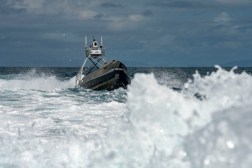Gilday: 7th Fleet to receive Project Overmatch capabilities

After the Navy wraps up experimentation with the USS Carl Vinson carrier strike group, the service is planning to roll out its Project Overmatch capabilities in the Indo-Pacific, including to 7th Fleet, Chief of Naval Operations Adm. Michael Gilday said Wednesday.
The highly secretive Project Overmatch is the Navy’s contribution to the Defense Department’s Joint All-Domain Command and Control (JADC2) initiative — a multi-billion-dollar effort to better connect the U.S. military’s many sensors, shooters and networks across the services. Gilday has said Project Overmatch will be the “bedrock for the joint tactical network of the future.”
The Navy is investing $226 million into the effort in fiscal 2023 and it’s requesting $192 million for fiscal 2024.
“What we wanted to try and do with this project is be able to take any data, containerize it and send it over any network. So instead of building a whole new operational infrastructure, [the aim] is to basically leverage what we have, primarily leveraging commercial technology, right, and just pivoting it to a military use,” Gilday explained at a Brookings Institution event Wednesday.
The initiative includes software-defined networking, he noted, “prioritizing what data is most important, and where it ends up and by what path.”
The sea service has had “great success” leveraging industry-provided technology, and it’s also been working with its allies and partners including the U.K., France and Australia, Gilday noted, adding that he expects that type of cooperation to expand over time.
The Carl Vinson carrier strike group has been putting the technology through its paces off the West Coast in the 3rd Fleet area of operations.
“We’re now experimenting with a carrier strike group. So think about eight ships, across many different networks, for many types of data …. It is a DevOps kind of environment, so we’re learning as we’re doing,” Gilday said.
DefenseScoop asked Gilday about next steps and the Navy’s plans to roll out Project Overmatch capabilities more broadly across the force.
“I think it will likely focus in the Pacific first and then expand globally into our other fleets,” he told DefenseScoop at the Brookings event. He confirmed that 7th Fleet, which is headquartered in Japan and operates in the Western Pacific, will be receiving the capabilities.
Gilday later told DefenseScoop that the Navy hasn’t nailed down a timeline for when that rollout to 7th Fleet will happen, saying he wants to see the final results from the Vinson experiments before service leaders make a decision about that.






